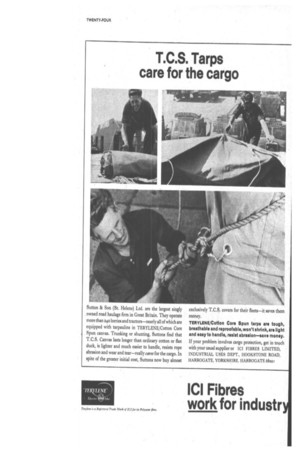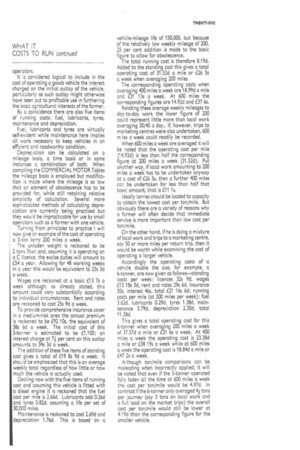T.C.S. Tarps care for the cargo
Page 92

Page 93

Page 94

If you've noticed an error in this article please click here to report it so we can fix it.
Sutton & Son (St. Helens) Ltd. are the largest singly owned road haulage firm in Great Britain. They operate more than 240 lorries and tractors—nearly all of which are equipped with tarpaulins in TER YLENE/Cotton Core Spun canvas. Trunking or shunting, Suttons find that T.C.S. Canvas lasts longer than ordinary cotton or flax duck, is lighter and much easier to handle, resists rope abrasion and wear and tear—really cares for the cargo. In spite of the greater initial cost, Suttons now buy almost
exclusively T.C.S. covers for their fleets—it saves them money.
TERYLENE/Cotton Core Spun tarps are tough, breathable and reproofable, won't shrink, are light and easy to handle, resist abrasion—save money. If your problem involves cargo protection, get in touch with your usual supplier or ICI FIBRES LIMITED, INDUSTRIAL USES DEPT., HOOKSTONE ROAD, HARROGATE, YORKSHIRE. HARROGATE 68o2i
operators.
It is considered logical to include in the cost of operating a goods vehicle the interest charged on the initial outlay of the vehicle, particularly as such outlay might otherwise have been put to profitable use in furthering the basic agricultural interests of the farmer.
By a coincidence there are also five items of running costs: fuel, lubricants, tyres, maintenance and depreciation.
Fuel, lubricants and tyres are virtually self-evident while maintenance here implies all work necessary to keep vehicles in an efficient and roadworthy condition.
Depreciation can be calculated on a mileage basis, a time basis or in some instances a combination of both. When compiling the COMMERCIAL MOTOR Tables the mileage basis is employed but modification is made where the mileage is so low that an element of obsolescence has to be provided for, while still retaining relative simplicity of calculation, Several more sophisticated methods of calculating depreciation are currently being practised but they would be impracticable for use by small operators such as a farmer with one vehicle.
Turning from principles to practice I will now give an example of the cost of operating a 3-ton lorry 200 miles a week, The unladen weight is reckoned to be 2 tons 7cwt and, assuming it is operating on a C licence, the excise duties will amount to £54 a year. Allowing for 48 working weeks in a year this would be equivalent to 23s 3d a week, Wages are reckoned at a basic {13 7s a week although, as already stated, this amount could vary substantially according to individual circumstances. Rent and rates ore reckoned to cost 25s 9d a week.
To provide comprehensive insurance cover in c medium-risk area the annual premium is reckoned to be £92 10s, the equivalent of 38s 6d . a week. The initial cost of this 3-tanner is estimated to be £1,100; an interest charge at 71 per cent on this outlay amounts to 34s 3d a week.
The addition of these five items of standing cost gives a total of £19 8s 9d a week. It should be emphasized that this is an average weekly total regardless of how little or how much the vehicle is actually used.
Dealing now with the five items of running cost and assuming this vehicle is fitted with a diesel engine it is reckoned that the fuel cost per mile is 2.66d. Lubricants add 0.26d and tyres 0.82d, assuming a life per set of 30,000 miles.
Maintenance is reckoned to cost 2.69d and depreciation 1.76d. This is based on a vehicle-mileage life of 150,000, but because of the relatively low weekly mileage of 200, 25 per cent addition is made to the basic figure to allow for obsolescence. The total running cost is therefore 8.19d. Added to the standing cost this gives a total operating cost of 31,52d a Mile or £26 5s a week when averaging 200 miles. The corresponding operating costs when averaging 400 miles a week are 18.99d a mile and £31 13s a week, At 600 miles the corresponding figures are 14.92d and £37 6s. Relating these average weekly mileages to day-to-day work the lower figure of 200 could represent little more than local work averaging 30/40 a day., If, however, trips to marketing centres were also undertaken, 600 miles a week could readily be recorded.
When 600 miles a week are averaged it will be noted that the operating cost per mile (14.92d) is less than half the corresponding figure at 200 miles a week (31.52d). Put another way, if local work amounting to 200 miles a week has to be undertaken anyway at a cost of £26 5s, then a further 900 miles can be undertaken for less than half that basic amount, that is £11 is.
Ideally lorries should be loaded to capacity to obtain the lowest cost per ton/mile. But obviously there are a variety of reasons why a farmer will often decide that immediate service is more important than low cost per ton/mile.
On the other hand, if he is doing a mixture of local work and trips to a marketing centre, say 50 or more miles per return trip, then it would be worth while examining the cost of operating a larger vehicle.
Accordingly the operating costs of a vehicle double the size, for example, a 6-tanner, are now given as follows—standing costs per week: licences 32s 9d, wages £13 18s 3d, rent and rates 29s 6d, insurance 50s, interest 46s, total £21 16s 6d; running costs per mile (at 200 miles per week): fuel 3.62d, lubricants 0.29d, tyres 1.38d, maintenance 3,79d, depreciation 2.30d, total 11.38d.
This gives a total operating cost for this 6-tonner when averaging 200 miles a week of 37.57d a mile or £31 6s a week. At 400 miles a week the operating cost is 23.38d a mile or £38 19s a week while at 600 miles a week the operating cost is 18.84d a mile or £47 2s a week.
Although ton/mile comparisons can be misleading when incorrectly applied, it will be noted that even if the 3-tanner operated fully laden all the time at 600 miles a week the cost per ton/mile would be 4.97d. In contrast if the 6-tanner only averaged 4 tons per journey (say 3 tons on local work and a full load on the market trips) the overall cost per ton/mile would still be lower at 4.19d than the corresponding figure for the smaller vehicle. 38 bhp to 82 bhp--all diesel-engined and rated for payloads from around 1 ton to 2 tons. Any will climb a 1 in 1.4 gradient fully laden, says the maker, and all of them will take a host of farm or forestry implements. A six-speed all-synchromesh gearbox is standard, while the latest variant has a Ruthmann low-loading body that can be dropped to ground level.
In a quite different category are the Snow Trac and the Oanes Carrier. Both have tracks, yet are suitable for metalled roads. Already 70 Snow Tracs (from Sweden) are in use in Britain and they will climb "anything the driver is brave enough to have a go at"—certainly slopes steeper than 1 in 1 in bottom gear. With only 0,751b/sq ft track pressure they will traverse ground that would not support a man and will cross heather without crushing it, The cabin seats seven, and this VW-engined 1.5-litre machine uses about a gallon of petrol an i hour. Maximum speed s just under 20 mph and the Snow Trac will carry about half a ton and tow the same.
Altogether bigger stuff is the Danes, which weighs 51 tons unladen, will carry over 12 tons and has a 143 bhp International petrol engine. It can be used as a load carrier or equipped with implements. Although it is 18ft 9in long and 7ft 6in wide its track pressure is only about 3Ib/sq in unladen and it can climb gradients of 1 in 2.5. And a closing thought: if you can't run to a multipurpose load carrier, Dennis Bros Ltd, of Guildford, makes a device called the Extricator which is simply a transverse shaft carrying at each end a grooved roller. When these rollers are manually brought into contact with the tyres of a vehicle's driving wheels, the differential effect is damped out and single-wheel-spinning on loose ground is avoided.












































































































































